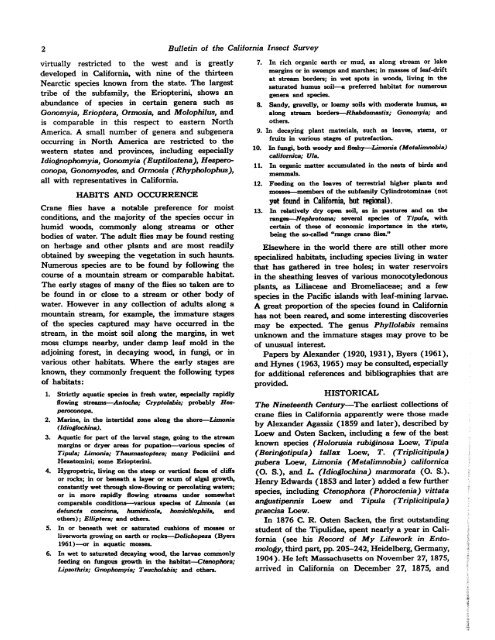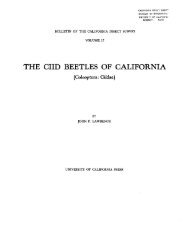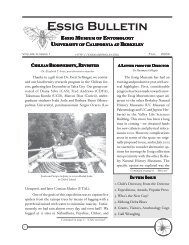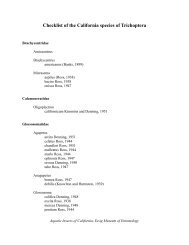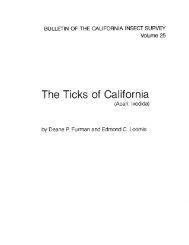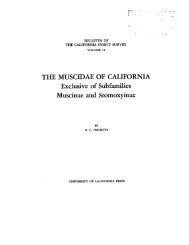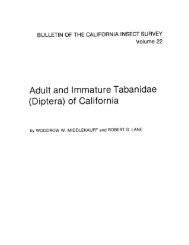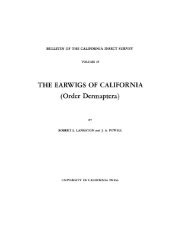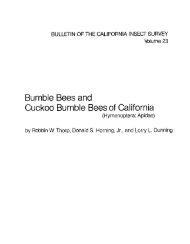The Crane Flies of California - Essig Museum of Entomology ...
The Crane Flies of California - Essig Museum of Entomology ...
The Crane Flies of California - Essig Museum of Entomology ...
You also want an ePaper? Increase the reach of your titles
YUMPU automatically turns print PDFs into web optimized ePapers that Google loves.
2 Bulletin <strong>of</strong> the <strong>California</strong> Insect Survey<br />
virtually restricted to the west and is greatly<br />
developed in <strong>California</strong>, with nine <strong>of</strong> the thirteen<br />
Nearctic species known from the state. <strong>The</strong> largest<br />
tribe <strong>of</strong> the subfamily, the Eriopterini, shows an<br />
abundance <strong>of</strong> species in certain genera such as<br />
Gonomyia, Erioptera, OnnoSia, and Molophilus, and<br />
is comparable in this respect to eastern North<br />
America. A small number <strong>of</strong> genera and subgenera<br />
occurring in North America are restricted to the<br />
western states and provinces, including especially<br />
Zdiognophomyia, Gonomyia (Euptilmtena), Hesperownopa,<br />
Gonomyodes, and Ormosia (Rhypholophus),<br />
all with representatives in <strong>California</strong>.<br />
HABITS AND OCCURRENCE<br />
<strong>Crane</strong> flies have a notable preference for moist<br />
conditions, and the majority <strong>of</strong> the species occur in<br />
humid woods, commonly along streams or other<br />
bodies <strong>of</strong> water. <strong>The</strong> adult flies may be found resting<br />
on herbage and other plants and are most readily<br />
obtained by sweeping the vegetation in such haunts.<br />
Numerous species are to be found by following the<br />
course <strong>of</strong> a mountain stream or comparable habitat.<br />
<strong>The</strong> early stages <strong>of</strong> many <strong>of</strong> the flies so taken are to<br />
be found in or close to a stream or other body <strong>of</strong><br />
water. However in any collection <strong>of</strong> adults along a<br />
mountain stream, for example, the immature stages<br />
<strong>of</strong> the species captured may have occurred in the<br />
stream, in the moist soil along the margins, in wet<br />
moss clumps nearby, under damp leaf mold in the<br />
adjoining forest, in decaying wood, in fungi, or in<br />
various other habitats. Where the early stages are<br />
known, they commonly frequent the following types<br />
<strong>of</strong> habitats:<br />
1. Strictly aquatic species in fresh water, especially rapidly<br />
flowing str-Ant&;<br />
CryptoZabis; probably Hesperoconopa.<br />
2. Marine, in the intertidal zone along the shorpLimonia<br />
(IdioBfochina).<br />
3. Aquatic for part <strong>of</strong> the larval stage, going to the stream<br />
margins or dryar areas for pupation-various species <strong>of</strong><br />
Tipula; Limonia; Thaumastoptera; many Pediciini and<br />
Hexatomini; some Eriopterini.<br />
4. Hygropetric, living on the steep or vertical faces <strong>of</strong> c1Ss<br />
or rocks; in or beneath a layer or scum <strong>of</strong> algal growth,<br />
constantly wet through slow-flowing or percolating waters;<br />
or in more rapidly flowing strenms under somewhat<br />
comparable conditiontivarious species <strong>of</strong> Limonia (as<br />
defuncta com*nna, humidicola, homichlophila, and<br />
others); Elliptera; and others.<br />
5. In or beneath wet or saturated cushions <strong>of</strong> mosses or<br />
liverworts growing on earth or mcks-Dolichopza (Byers<br />
1961)- in aquatic mosses.<br />
6. In wet to saturate dvaying wood, the larvae commonly<br />
feeding on fungoua growth in the habitst-ctenophra;<br />
Lipsothrix; Gnophomyia; Teucfiolabis; and others.<br />
7. In rich organic earth or mud, as along stream or lake<br />
margins or in swamps and marshes; in masses <strong>of</strong> leaf-drift<br />
at stream borders; in wet spots in woods, living in the<br />
saturated humus soil- preferred habitat for numerous<br />
genera and species.<br />
8. Sandy, gravelly, or loamy soils with moderate humus, as<br />
along stream bord-Rhabdomastix; Gonomyia; and<br />
ethers.<br />
9. In decaying plant materials, such as leaves, stems, or<br />
10.<br />
fruits in various stages <strong>of</strong> putrefaction.<br />
In fungi, both woody and fleahy-Limonia (Metalimmbia)<br />
califomica; Ula.<br />
11. In organic matter accumulated in the nesoi <strong>of</strong> birds and<br />
mammals.<br />
12. Feeding on the leaves <strong>of</strong> terrestrial higher plants and<br />
moss-members <strong>of</strong> the subfamily Cyliindrotominae (not<br />
yet found in <strong>California</strong>, but regianal).<br />
13. In relatively dry open soil, as in pastures and on the<br />
ranges-lliephmtoma; several species <strong>of</strong> Tipula, with<br />
certain <strong>of</strong> these <strong>of</strong> economic importance in the state,<br />
being the so-called “range crane flies.”<br />
Elsewhere in the world there are still other more<br />
specialized habitats, including species living in water<br />
that has gathered in tree holes; in water reservoirs<br />
in the sheathing leaves <strong>of</strong> various monocotyledonous<br />
plants, as Liliaceae and Bromeliaceae; and a few<br />
species in the Pacific islands with leaf-mining larvae.<br />
A great pmportion <strong>of</strong> the species found in <strong>California</strong><br />
has not been reared, and some interesting discoveries<br />
may be expected. <strong>The</strong> genus Phyllolabis remains<br />
unknown and the immature stages may prove to be<br />
<strong>of</strong> unusual interest<br />
Papers by Alexander (1920, 1931), Byers (1961),<br />
and Hynes (1963,1965) may be consulted, especially<br />
for additional references and bibliographies that are<br />
provided<br />
HISTORICAL<br />
<strong>The</strong> Nineteenth Century-<strong>The</strong> earliest collections <strong>of</strong><br />
crane flies in <strong>California</strong> apparently were those made<br />
by Alexander Agassiz (1859 and later), described by<br />
k w and Osten Sacken, including a few <strong>of</strong> the best<br />
known species (Holorusia rubiginma Loew, Tipula<br />
(Beringotipula) fallax Loew, T. (Triplicitipula)<br />
pubera Loew, Limonia (Metalimnobia) californica<br />
(0. S.), and L. (Zdioglmhha) marmorata (0. S.).<br />
Henry Edwards (1853 and later) added a few further<br />
species, including Ctenophora (Phoroctenia) vittata<br />
angustipnnis Loew and Tipula (Triplicitipula)<br />
praecisa hew.<br />
In 1876 C. R. Osten Sacken, the first outstanding<br />
student <strong>of</strong> the Tipulidae, spent nearly a year in <strong>California</strong><br />
(see his Record <strong>of</strong> My Lifework in <strong>Entomology</strong>,<br />
third part, pp. 205-242, Heidelberg, Germany,<br />
1904). He left Massachusetts on November 27, 1875,<br />
arrived in <strong>California</strong> on December 27, 1875, and


